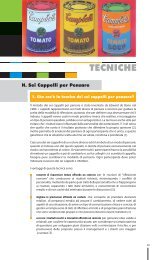Creativity Theory - TRaining MAterial in Creativity and InnovaTion ...
Creativity Theory - TRaining MAterial in Creativity and InnovaTion ...
Creativity Theory - TRaining MAterial in Creativity and InnovaTion ...
You also want an ePaper? Increase the reach of your titles
YUMPU automatically turns print PDFs into web optimized ePapers that Google loves.
20<br />
A. ESSENTIALS<br />
product design. Creative communities also<br />
help to make organisations more dist<strong>in</strong>ctive<br />
<strong>and</strong> better known for their uniqueness.<br />
<strong>Creativity</strong> is considered important <strong>in</strong><br />
an education system: children are not<br />
frightened of be<strong>in</strong>g wrong. If you are not<br />
prepared to be wrong you will not come<br />
up with anyth<strong>in</strong>g orig<strong>in</strong>al. By promot<strong>in</strong>g<br />
creativity, teachers can give all children<br />
the opportunity to discover <strong>and</strong> pursue<br />
their particular <strong>in</strong>terests <strong>and</strong> talents.<br />
Moreover its significance is demonstrated<br />
<strong>in</strong> everyday life: creativity is a vital force<br />
that must be nurtured, motivated, given<br />
freedom, stimulated <strong>and</strong> encouraged to<br />
express itself <strong>in</strong> ways that current social<br />
priorities or <strong>in</strong>tellectual paradigms may<br />
not recognize as important or productive.<br />
However, creativity also means change <strong>and</strong><br />
resistance to change is a natural phenomenon.<br />
So, to promote creativity <strong>in</strong> organizations,<br />
we must be more aware of the unhelpful<br />
reactions to change, such as, rejection<br />
of ideas <strong>and</strong> status-dom<strong>in</strong>ated evaluations<br />
1 . There are many obstacles <strong>and</strong><br />
potential barriers to creativity that can<br />
be identified. Someone for example th<strong>in</strong>ks<br />
that the conventional system of school<strong>in</strong>g<br />
(particularly <strong>in</strong> pre-school <strong>and</strong> early school<br />
years) as be<strong>in</strong>g “stifl<strong>in</strong>g” <strong>in</strong> terms of creativity<br />
<strong>and</strong> attempts are made to provide a<br />
creativity-friendly <strong>and</strong> rich, imag<strong>in</strong>ationfoster<strong>in</strong>g<br />
environment for young children.<br />
Meanwhile, <strong>in</strong> the workplace, once the<br />
company has <strong>in</strong>stalled certa<strong>in</strong> systems,<br />
the risk is that there will eventually be resistance<br />
to change. Also rules, regulations<br />
<strong>and</strong> procedures can be obstacles h<strong>in</strong>der<strong>in</strong>g<br />
creativity <strong>in</strong> organizations: if these<br />
rules, regulations <strong>and</strong> procedures become<br />
ends to themselves, employees will just<br />
rigidly apply them <strong>in</strong> every situation. So,<br />
it is important that a reward system exists<br />
<strong>in</strong> organizations which is appropriate <strong>and</strong><br />
which does not stifle creativity. When the<br />
reward systems are too punitive on failures,<br />
they will discourage employees from<br />
tak<strong>in</strong>g risks, but it is also true that when<br />
they over-emphasize <strong>in</strong>dividual creativity,<br />
they may discourage group creativity.<br />
3. <strong>Creativity</strong>: problem<br />
solv<strong>in</strong>g <strong>and</strong> environment<br />
Creative problem-solv<strong>in</strong>g is the mental<br />
process of creat<strong>in</strong>g a solution to a problem.<br />
It is a special form of problem-solv<strong>in</strong>g <strong>in</strong><br />
which the solution is <strong>in</strong>dependently created<br />
rather than learned with assistance.<br />
Creative problem-solv<strong>in</strong>g requires more<br />
than just knowledge <strong>and</strong> th<strong>in</strong>k<strong>in</strong>g <strong>and</strong> always<br />
<strong>in</strong>volves creativity. <strong>Creativity</strong> requires<br />
newness or novelty as a characteristic of<br />
what is created, but it does not necessarily<br />
imply that what is created has value<br />
or is appreciated by other people. So, to<br />
qualify as creative problem-solv<strong>in</strong>g the<br />
solution must either have value, clearly<br />
solve the stated problem or be appreciated<br />
by someone for whom a situation<br />
improves. Creative problem-solv<strong>in</strong>g<br />
techniques can be categorized as follows:<br />
<strong>Creativity</strong> techniques designed to<br />
shift a person’s mental state <strong>in</strong>to<br />
one that fosters creativity. One<br />
such popular technique is to take<br />
a break <strong>and</strong> relax after <strong>in</strong>tensively<br />
try<strong>in</strong>g to th<strong>in</strong>k of a solution.<br />
<strong>Creativity</strong> techniques designed to<br />
reframe the problem. For example,<br />
reconsider<strong>in</strong>g one’s goals by ask<strong>in</strong>g<br />
“What am I really try<strong>in</strong>g to accomplish?”<br />
can lead to useful <strong>in</strong>sights.<br />
<strong>Creativity</strong> techniques designed to <strong>in</strong>crease<br />
the quantity of fresh ideas. This<br />
approach is based on the belief that a<br />
larger number of ideas <strong>in</strong>crease the<br />
chances that one of them has value.<br />
Some of these techniques <strong>in</strong>volve<br />
r<strong>and</strong>omly select<strong>in</strong>g an idea (such as<br />
choos<strong>in</strong>g a word from a list), th<strong>in</strong>k<strong>in</strong>g<br />
about similarities with the undesired<br />
situation <strong>and</strong> hopefully <strong>in</strong>spir<strong>in</strong>g a<br />
related idea that leads to a solution.<br />
Creative-problem-solv<strong>in</strong>g techniques<br />
designed to efficiently lead to a fresh<br />
perspective that causes a solution<br />
to become obvious. This category<br />
is especially useful for solv<strong>in</strong>g especially<br />
challeng<strong>in</strong>g problems. Some of<br />
these techniques <strong>in</strong>volve identify<strong>in</strong>g<br />
<strong>in</strong>dependent dimensions that differentiate<br />
(or separate) closely associated<br />
concepts. Such techniques<br />
can overcome the m<strong>in</strong>d’s <strong>in</strong>st<strong>in</strong>ctive



